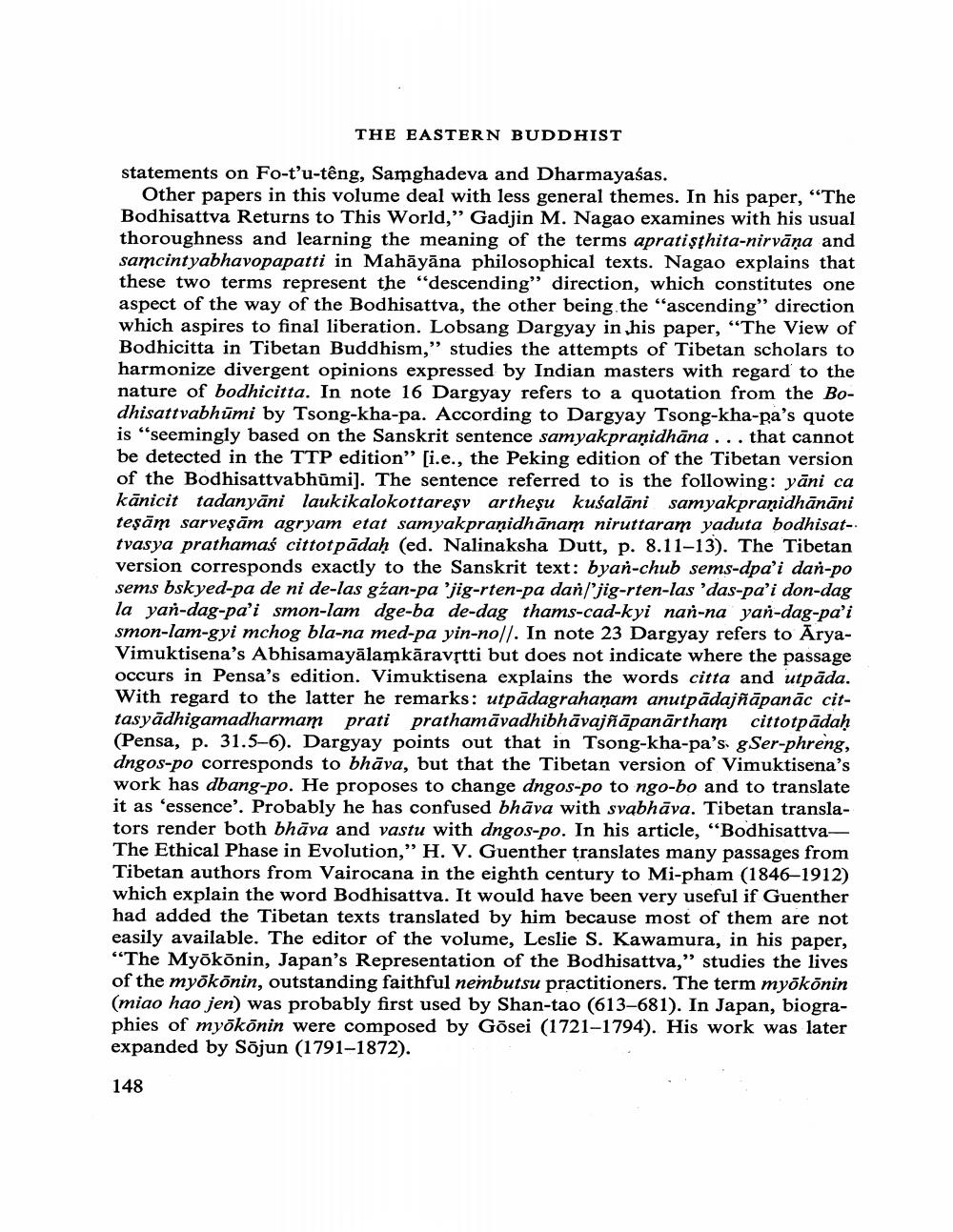________________
THE EASTERN BUDDHIST
statements on Fo-t'u-têng, Samghadeva and Dharmayasas.
Other papers in this volume deal with less general themes. In his paper, "The Bodhisattva Returns to This World," Gadjin M. Nagao examines with his usual thoroughness and learning the meaning of the terms apratisthita-nirvana and samcintyabhavopapatti in Mahāyāna philosophical texts. Nagao explains that these two terms represent the "descending" direction, which constitutes one aspect of the way of the Bodhisattva, the other being the "ascending" direction which aspires to final liberation. Lobsang Dargyay in his paper, "The View of Bodhicitta in Tibetan Buddhism," studies the attempts of Tibetan scholars to harmonize divergent opinions expressed by Indian masters with regard to the nature of bodhicitta. In note 16 Dargyay refers to a quotation from the Bodhisattvabhumi by Tsong-kha-pa. According to Dargyay Tsong-kha-pa's quote is "seemingly based on the Sanskrit sentence samyakpranidhāna... that cannot be detected in the TTP edition" [i.e., the Peking edition of the Tibetan version of the Bodhisattvabhümi]. The sentence referred to is the following: yani ca känicit tadanyäni laukikalokottaresy artheşu kušaläni samyakpranidhänäni teşām sarveṣām agryam etat samyakpranidhanam niruttaram yaduta bodhisattvasya prathamas cittotpadaḥ (ed. Nalinaksha Dutt, p. 8.11-13). The Tibetan version corresponds exactly to the Sanskrit text: byan-chub sems-dpa'i dan-po sems bskyed-pa de ni de-las gan-pa 'jig-rten-pa dan/"jig-rten-las 'das-pa'i don-dag la yan-dag-pa'i smon-lam dge-ba de-dag thams-cad-kyi nan-na yañ-dag-pa'i smon-lam-gyi mchog bla-na med-pa yin-no//. In note 23 Dargyay refers to AryaVimuktisena's Abhisamayalamkaravṛtti but does not indicate where the passage occurs in Pensa's edition. Vimuktisena explains the words citta and utpada. With regard to the latter he remarks: utpädagrahaṇam anutрādajñāpanāc cittasyadhigamadharmam prati prathamävadhibhāvajñāpanärtham cittotpädaḥ (Pensa, p. 31.5-6). Dargyay points out that in Tsong-kha-pa's. gSer-phreng, dngos-po corresponds to bhāva, but that the Tibetan version of Vimuktisena's work has dbang-po. He proposes to change dngos-po to ngo-bo and to translate it as 'essence'. Probably he has confused bhava with svabhāva. Tibetan translators render both bhava and vastu with dngos-po. In his article, "BodhisattvaThe Ethical Phase in Evolution," H. V. Guenther translates many passages from Tibetan authors from Vairocana in the eighth century to Mi-pham (1846-1912) which explain the word Bodhisattva. It would have been very useful if Guenther had added the Tibetan texts translated by him because most of them are not easily available. The editor of the volume, Leslie S. Kawamura, in his paper, "The Myōkōnin, Japan's Representation of the Bodhisattva," studies the lives of the myōkōnin, outstanding faithful nembutsu practitioners. The term myōkōnin (miao hao jen) was probably first used by Shan-tao (613-681). In Japan, biographies of myōkōnin were composed by Gosei (1721-1794). His work was later expanded by Söjun (1791-1872).
148




